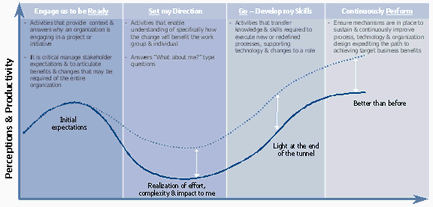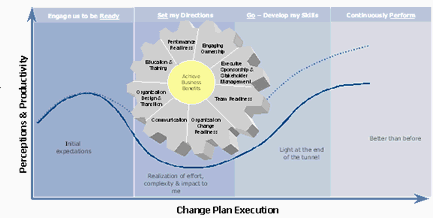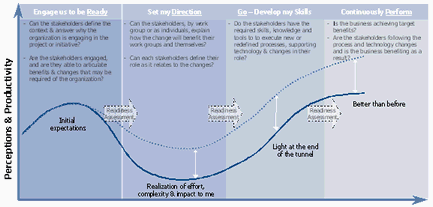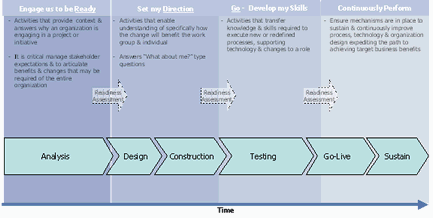Managing Change & Improving People's Performance
Download a PDF of Managing Change & Improving People's Performance.
In today’s business, change is a norm and organizations are slowly realizing that change, if not addressed, can cause major havoc on productivity of the employees, as well as relationships with customers and vendors. Organizations are beginning to recognize that the ultimate success of any major change initiative is directly correlated to the ability of the organization’s people to adapt and manage change as an inevitable reality of the business climate.
This paper will discuss the benefits of utilizing People & Performance Solutions™ Change Management Methodology and the process for deploying this structured methodology.
Defining Change Management
Change Management focuses on preparing impacted stakeholders (anyone who can influence or is impacted by a change) to be engaged and ready for the initiative, to understand how this will affect them, to know how and when they will receive the requisite skills so that all impacted stakeholders in the changing environment will succeed in sustaining improved performance. People & Performance Solutions five guiding principles are the foundation of their comprehensive methodology:
- Change Management is a thoughtful, planned, consistent, customizable, repeatable process
The Business Need for Change Management
All business benefits sustained from a change will be derived through people, not through a network of business processes and technologies. The key difference between companies that succeed or fail in any type of business transformation (e.g., a strategy, process, technology or organizational restructuring implementation) is the degree of attention paid to the needs of the employees, vendors and customers who will be required to function in the changed business environment.
As shown in the chart below, the change associated with an initiative or project implementation will impact how stakeholders perceive their role, which has a direct correlation on their productivity. In the early stages of any business transformation, large or small, people form initial expectations or impressions base
d upon what the benefit of the transformation will be for the organization as a whole. Once they begin to receive more detail, they begin to ask how the initiative will impact their work group and them; and they begin to ask “What about me?” This is a crucial stage. If their questions are not appropriately answered, their perceptions and, in turn, their productivity will begin to spiral downward. The lack of information will cause them to fill in the blanks for themselves with information that may or may not be factual, thus creating barriers to the implementation that could be costly to overcome. If their questions are addressed effectively and they see how they will eventually fit into the solution, the risk is managed and their perceptions and in turn their productivity begins to increase.
A successfully executed change program should prevent a dip in employee perception/productivity as indicated by the dashed line in the Change Management Opportunity Curve below:

The business benefit that an organization plans to achieve is directly related to a successfully implemented change program. The ultimate benefit is that the change does not cause disruptions to daily operations, which in turn does not cause a dip in productivity. Thus, an effective change management program should reduce the time it takes to achieve and sustain business benefits such as increased revenue or improved customer satisfaction.
The Benefits of Implementing the Right Methodology
Deploying People & Performance Solutions proven and comprehensive change management methodology will ensure delivery of the following benefits:
| Benefits of Deploying P&PS Change Management Methodology | Risk of Omission |
| Deterrent to fluctuations in employee productivity both pre and post implementation | Employee productivity declines and unmanaged resistance leads to implementation failure and lost revenue |
| Reduced time it takes to achieve and sustain targeted business benefits due to alleviation of productivity fluctuations | Time to achieve and sustain planned business benefits is longer than anticipated due to inability to effectively manage change |
| A structure and toolkit to analyze, plan and manage change that is comprehensive and flexible | Change impacts are overlooked or not addressed which contributes to stakeholder resistance and productivity decline |
| A proactive approach to change management that is deliverable based, planned, repeatable, measurable, consistent, customizable | Chaotic; Ready, fire, aim reactive approach |
| Check points and tools to measure readiness of the stakeholder population while also ensuring that mechanisms are put in place to sustain the benefit over time | Inability to deliver the business results and sustain the benefit over time |
A number of change management consulting firms have developed thorough methodologies to help their clients cope with change. However, when these methodologies are not structured or implemented properly, organizations have a high certainty of dipping below an acceptable level of productivity, as shown in the Change Management Opportunity Curve. What causes the dip can be a number of things, but the most common pitfalls that a poorly executed methodology will exhibit are:
- Failure to identify or put into place mechanisms to sustain desired behaviors/processes to achieve/sustain business benefits. If sustaining mechanisms are not planned prior to implementation, the risk of employees reverting to old behaviors is very high.
- Lack of structured, tangible approach to address executive sponsorship.
- Lack of project management discipline causes issues to be left unidentified and/or unresolved.
- Not preparing or involving the right people outside the project/initiative in critical decision-making.
- Thinking that training alone is change management and prepares people for change.
- Not presenting the big picture for stakeholders so they know exactly what to expect and when to expect it.
People & Performance Solutions Change Management Method and Approach
Stakeholders' needs are not one-size-fits-all. Any change management solution should be role based or incorporate segmentation - that is, determining how the needs of each stakeholder differ and how to create a change management plan for each group. People & Performance Solutions developed a methodology to prepare stakeholders to successfully develop and implement a change plan that effectively transfers the knowledge and ownership of managing change to stakeholders. Their methodology is easily understandable, well-defined, repeatable, customizable and flexible. The methodology is designed to be consistent across an organization, yet flexible enough to add enhancements based upon unique business practices. It is comprised of four stages of engagement utilizing eight change management levers that helps each stakeholder group develop a change implementation plan.
Stages of Stakeholder Engagement and Change Components
As the diagram shows below, there are four stages of engagement: Ready, Set, Go Perform. Engage us to be Ready; Set my direction; Go – Develop my Skills; and Continuously Perform. At each stage of engagement, the stakeholder group change impacts and change components are analyzed and the appropriate change activities for that stage are determined.

The following provides a definition for each of the change components developed:
Executive Sponsorship & Stakeholder Management – Change is sponsored and supported by executive leadership and interactions are managed with anyone who has influence over or is impacted by the change.
Team Readiness – Employees who have responsibility for leading or implementing any aspect of the change program have the necessary education, training, tools and support to execute their responsibilities.
Organization Change Readiness – Organizational cultural characteristics and change capabilities are acknowledged and understood.
Communication – Stakeholders are kept informed in a timely manner of relevant information.
Organization Design & Transition – Ensuring the appropriate organization structure, reporting relationships, roles, responsibilities, performance measures and methods of interaction have been designed to support the changed business model.
Education and Training – Opportunities for stakeholders to develop the skill and knowledge required to effectively operate in the new environment.
Engaging Ownership – The change will be planned, led and owned by appropriate client employees.
Performance Readiness – Mechanisms will be developed to measure and monitor change plan and organization performance, contribution and sustainability of business benefits.

Implementing the change components in relation to the stages will result in stakeholders building a comprehensive understanding of the following key aspects of managing change:
- Why changes are needed and how employees and the business will be impacted
- Why, when and how the changes will be implemented
- Importance of checkpoints to monitor and adjust the plan accordingly based upon employee knowledge of the required changes
- Social, process and technical skills education and training required to be successful in the new business environment
- Established readiness criteria to determine if employees have developed the skills and knowledge to operate effectively in the new business environment
- Metrics designed to align desired performance and behavioral changes with business objectives to ensure benefit sustainability and continuous improvement
Assessing Stakeholder Readiness
As the change management activities are executed, associated with each change lever, a readiness assessment checkpoint is used to evaluate the effectiveness of the activities at each stage. As indicated before, there are four stages: Engage us to be Ready; Set my direction; Go – Develop my skills; and Continuously Perform.

People & Performance Solutions has developed a readiness assessment toolkit that is designed to measure the readiness at the completion of activities planned in each stage of engagement of the change plan. By utilizing the toolkit throughout the change program, an organization can ensure that all stakeholders have answered the following questions:
- What is changing and why is it changing?
- How will I be impacted?
- What is in it for me?
- How will I get the knowledge, skills and information that I need?
- What do you need for me to do?
Change Management Method Roadmap
One of the most crucial pieces of a change management program is the appropriate sequence and timing of implementation. In order to obtain maximum rewards, a change management plan must align with the strategy, process and technology components of the project or initiative, as shown below:

Not aligning the change management plan at each phase of business transformation will impact the rate at which the stakeholders understand and accept the changes and will negatively impact the initiative benefits. At each phase of the implementation, key change management activities are executed, so that when the stakeholders are directly facing the changes, they have had time to understand, accept and learn the changes.
Putting the Pieces into Place
It is important to understand that managing change cannot be accomplished by implementing an effective training program. There are series of activities, as illustrated in this paper, that are pertinent for preparing people in organizations to acclimate and to embrace any change. Stepping people diligently through the process will give people the opportunity to be a catalyst for change, instead of a roadblock to change.
Summary
Managing change is challenging because it requires transitioning people from what they used to do to what you want them to do. This transition can be unpredictable and risky. In order to mitigate the unpredictability and risk of change, People & Performance Solutions has developed a method and strategy that requires:
- Defining the impact of changes from an employee perspective
- Utilizing employee change impact understanding to facilitate development of a comprehensive, flexible, customizable change plan that is fully integrated with the process and technology components of a project/implementation
- Ensuring that a network of client resources are fully engaged in order to develop and own change plans that will be implemented in their respective organizations
- Ensuring that processes and programs are implemented that address benefit sustainability and continuous improvement
Successful execution of a change program will enable organizations to successfully implement and realize the benefits of any project or initiative, especially when employees are valuable components of the continued success of the business.
|






